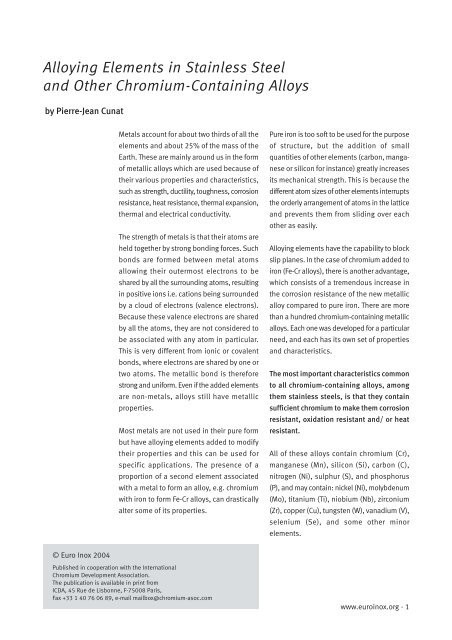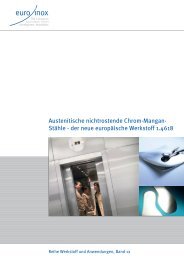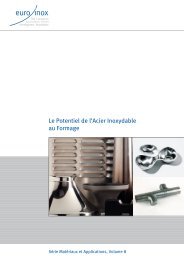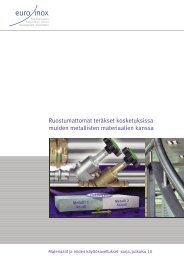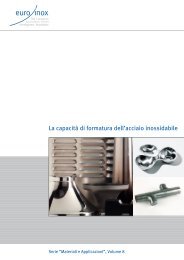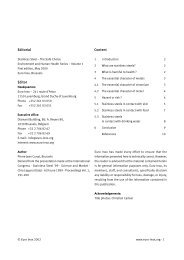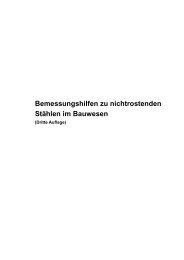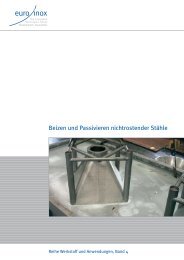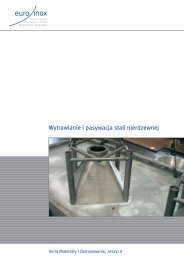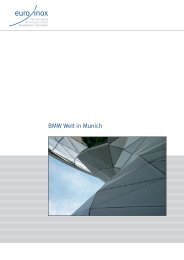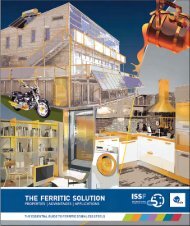Alloying Elements in Stainless Steel and Other Chromium - Euro Inox
Alloying Elements in Stainless Steel and Other Chromium - Euro Inox
Alloying Elements in Stainless Steel and Other Chromium - Euro Inox
Create successful ePaper yourself
Turn your PDF publications into a flip-book with our unique Google optimized e-Paper software.
<strong>Alloy<strong>in</strong>g</strong> <strong>Elements</strong> <strong>in</strong> Sta<strong>in</strong>less <strong>Steel</strong><br />
<strong>and</strong> <strong>Other</strong> <strong>Chromium</strong>-Conta<strong>in</strong><strong>in</strong>g Alloys<br />
by Pierre-Jean Cunat<br />
© <strong>Euro</strong> <strong>Inox</strong> 2004<br />
Metals account for about two thirds of all the<br />
elements <strong>and</strong> about 25% of the mass of the<br />
Earth. These are ma<strong>in</strong>ly around us <strong>in</strong> the form<br />
of metallic alloys which are used because of<br />
their various properties <strong>and</strong> characteristics,<br />
such as strength, ductility, toughness, corrosion<br />
resistance, heat resistance, thermal expansion,<br />
thermal <strong>and</strong> electrical conductivity.<br />
The strength of metals is that their atoms are<br />
held together by strong bond<strong>in</strong>g forces. Such<br />
bonds are formed between metal atoms<br />
allow<strong>in</strong>g their outermost electrons to be<br />
shared by all the surround<strong>in</strong>g atoms, result<strong>in</strong>g<br />
<strong>in</strong> positive ions i.e. cations be<strong>in</strong>g surrounded<br />
by a cloud of electrons (valence electrons).<br />
Because these valence electrons are shared<br />
by all the atoms, they are not considered to<br />
be associated with any atom <strong>in</strong> particular.<br />
This is very different from ionic or covalent<br />
bonds, where electrons are shared by one or<br />
two atoms. The metallic bond is therefore<br />
strong <strong>and</strong> uniform. Even if the added elements<br />
are non-metals, alloys still have metallic<br />
properties.<br />
Most metals are not used <strong>in</strong> their pure form<br />
buthave alloy<strong>in</strong>g elements added to modify<br />
their properties <strong>and</strong> this can be used for<br />
specific applications. The presence of a<br />
proportion of a second element associated<br />
with a metal to form an alloy, e.g. chromium<br />
with iron to form Fe-Cr alloys, can drastically<br />
alter some of its properties.<br />
Published <strong>in</strong> cooperation with the International<br />
<strong>Chromium</strong> Development Association.<br />
The publication is available <strong>in</strong> pr<strong>in</strong>t from<br />
ICDA, 45 Rue de Lisbonne, F-75008 Paris,<br />
Fax +33 1 40 76 06 89, e-mail mailbox@chromium-asoc.com<br />
Pure iron is too soft to be used for the purpose<br />
of structure, but the addition of small<br />
quantities of other elements (carbon, manganese<br />
or silicon for <strong>in</strong>stance) greatly <strong>in</strong>creases<br />
its mechanical strength. This is because the<br />
different atom sizes of other elements <strong>in</strong>terrupts<br />
the orderly arrangement of atoms <strong>in</strong> the lattice<br />
<strong>and</strong> prevents them from slid<strong>in</strong>g over each<br />
other as easily.<br />
<strong>Alloy<strong>in</strong>g</strong> elements have the capability to block<br />
slip planes. In the case of chromium added to<br />
iron (Fe-Cr alloys), there is another advantage,<br />
which consists of a tremendous <strong>in</strong>crease <strong>in</strong><br />
the corrosion resistance of the new metallic<br />
alloy compared to pure iron. There are more<br />
than a hundred chromium-conta<strong>in</strong><strong>in</strong>g metallic<br />
alloys. Each one was developed for a particular<br />
need, <strong>and</strong> each has its own set of properties<br />
<strong>and</strong> characteristics.<br />
The most important characteristics common<br />
to all chromium-conta<strong>in</strong><strong>in</strong>g alloys, among<br />
them sta<strong>in</strong>less steels, is that they conta<strong>in</strong><br />
sufficient chromium to make them corrosion<br />
resistant, oxidation resistant <strong>and</strong>/ or heat<br />
resistant.<br />
All of these alloys conta<strong>in</strong> chromium (Cr),<br />
manganese (Mn), silicon (Si), carbon (C),<br />
nitrogen (Ni), sulphur (S), <strong>and</strong> phosphorus<br />
(P), <strong>and</strong> may conta<strong>in</strong>: nickel (Ni), molybdenum<br />
(Mo), titanium (Ti), niobium (Nb), zirconium<br />
(Zr), copper (Cu), tungsten (W), vanadium (V),<br />
selenium (Se), <strong>and</strong> some other m<strong>in</strong>or<br />
elements.<br />
www.euro<strong>in</strong>ox.org · 1
ALLOYING ELEMENTS IN STAINLESS STEEL<br />
Sta<strong>in</strong>less <strong>Steel</strong>s<br />
Sta<strong>in</strong>less <strong>Steel</strong> is a generic term for a large<br />
family of corrosion resistant alloys conta<strong>in</strong><strong>in</strong>g<br />
at least 10.50% chromium (accord<strong>in</strong>g to the<br />
<strong>Euro</strong>pean st<strong>and</strong>ard EN10088) <strong>and</strong> may<br />
conta<strong>in</strong> other alloy<strong>in</strong>g elements. Sta<strong>in</strong>less<br />
steels can be divided <strong>in</strong>to five categories:<br />
martensitic, ferritic, austenitic, austeniticferritic<br />
so-called duplex, <strong>and</strong> precipitation<br />
harden<strong>in</strong>g (PH).<br />
Martensitic Sta<strong>in</strong>less <strong>Steel</strong>s:<br />
Fe-Cr-C-(Ni-Mo) alloys<br />
These alloys have a chromium content that<br />
ranges from 11.50 to 18.00%. They have<br />
relatively high carbon content from 0.15 to<br />
1.20% compared to other sta<strong>in</strong>less steels<br />
<strong>and</strong> molybdenum can also be used. These<br />
grades can be hardened through heat<br />
treatment to offer strength <strong>and</strong> hardness.<br />
They are magnetic. The common uses are<br />
knife blades, surgical <strong>in</strong>struments, shafts,<br />
etc.<br />
Ferritic Sta<strong>in</strong>less <strong>Steel</strong>: Fe-Cr-(Mo) alloys<br />
In ferritic grades, carbon is kept to low levels<br />
(C
© <strong>Euro</strong> <strong>Inox</strong> 2004<br />
steels. Common uses are <strong>in</strong> mar<strong>in</strong>e applications,<br />
petrochemical plant, desal<strong>in</strong>ation plant, heat<br />
exchangers <strong>and</strong> papermak<strong>in</strong>g <strong>in</strong>dustry.<br />
Precipitation Harden<strong>in</strong>g (PH):<br />
Fe-Cr-Ni-(Mo-Al-Cu-Nb)-N alloys<br />
High strength, middl<strong>in</strong>g corrosion resistance<br />
<strong>and</strong> ease of fabrication are the primary<br />
benefits offered by this family of sta<strong>in</strong>less<br />
steel grades. These grades develop very high<br />
strength after a low temperature (500-800°C)<br />
heat treatment. S<strong>in</strong>ce lower temperature can<br />
be used, concerns with part distortion are<br />
ALLOYING ELEMENTS IN STAINLESS STEEL<br />
m<strong>in</strong>imized, allow<strong>in</strong>g them to be used for high<br />
precision parts. Precipitation-hardened<br />
sta<strong>in</strong>less steels have an <strong>in</strong>itial microstructure<br />
of austenite or martensite. Austenitic grades<br />
are converted to martensitic grades through<br />
heat treatment before precipitation harden<strong>in</strong>g<br />
can be done. Precipitation harden<strong>in</strong>g (PH)<br />
results when the heat ag<strong>in</strong>g treatment causes<br />
hard <strong>in</strong>termetallic compounds to precipitate<br />
from the crystal lattice as the martensite is<br />
tempered.<br />
Common uses are <strong>in</strong> the aerospace <strong>and</strong> some<br />
other high-technology <strong>in</strong>dustries.<br />
www.euro<strong>in</strong>ox.org · 3
ALLOYING ELEMENTS IN STAINLESS STEEL<br />
2. Carbon<br />
Carbon is a non-metallic element, which is<br />
an important alloy<strong>in</strong>g element <strong>in</strong> all-ferrous<br />
metal based materials. Carbon is always<br />
present <strong>in</strong> metallic alloys, i.e. <strong>in</strong> all grades of<br />
sta<strong>in</strong>less steel <strong>and</strong> heat resistant alloys.<br />
Carbon is a very strong austenitizer <strong>and</strong><br />
<strong>in</strong>creases the strength of steel.<br />
In austenitic, ferritic, <strong>and</strong> duplex sta<strong>in</strong>less steels,<br />
it is kept to low levels (typically 0.005% C to<br />
0.03% C <strong>in</strong> low carbon grades) to reta<strong>in</strong> the<br />
desired properties <strong>and</strong> mechanical characteristics.<br />
In martensitic sta<strong>in</strong>less steels, carbon is<br />
deliberately added to obta<strong>in</strong> both high strength<br />
<strong>and</strong> high hardness, thanks to the formation<br />
of a martensitic structure.<br />
In martensitic grades, carbon is added as an<br />
alloy<strong>in</strong>g element, <strong>in</strong> amounts vary<strong>in</strong>g from<br />
0.15% to 1.2% to make these alloys heat<br />
treatable by quench<strong>in</strong>g <strong>and</strong> temper<strong>in</strong>g to<br />
develop this martensite phase.<br />
The pr<strong>in</strong>cipal effect of carbon on corrosion<br />
resistance is determ<strong>in</strong>ed by the way <strong>in</strong> which<br />
it exists <strong>in</strong> the alloy.<br />
If it is comb<strong>in</strong>ed with chromium as a separate<br />
constituent (chromium carbide), it may have<br />
a detrimental effect on corrosion resistance by<br />
remov<strong>in</strong>g some of the chromium from solid<br />
solution <strong>in</strong> the alloy <strong>and</strong>, as a consequence,<br />
reduc<strong>in</strong>g the amount of chromium available<br />
to ensure corrosion resistance. This adverse<br />
effect of carbon can be caused if the alloy is<br />
cooled too slowly after hot work<strong>in</strong>g or<br />
anneal<strong>in</strong>g or subsequently reheated (as <strong>in</strong><br />
weld<strong>in</strong>g operations). The consequence is an<br />
unwanted precipitation of carbide-conta<strong>in</strong><strong>in</strong>g<br />
chromium. This precipitation of carbon takes<br />
place at gra<strong>in</strong> boundaries <strong>and</strong> is referred to as<br />
sensitisation. It has been demonstrated that<br />
the loss of chromium associated with the<br />
carbide precipitation lowers corrosion<br />
resistance <strong>and</strong> br<strong>in</strong>gs about susceptibility to<br />
localised corrosion, i.e. <strong>in</strong>tergranular corrosion,<br />
at the gra<strong>in</strong> boundaries follow<strong>in</strong>g the network<br />
of chromium carbides.<br />
Graphite – Lake Harbour (Canada) – Courtesy of Ecole des<br />
M<strong>in</strong>es de Paris<br />
4 · www.euro<strong>in</strong>ox.org © <strong>Euro</strong> <strong>Inox</strong> 2004
3. <strong>Chromium</strong><br />
© <strong>Euro</strong> <strong>Inox</strong> 2004<br />
3.1 Discovery, History <strong>and</strong><br />
Sources<br />
In 1797, the French professor of chemistry,<br />
Louis-Nicolas Vauquel<strong>in</strong> discovered chromium<br />
oxide, as a part of "red lead” (lead chromate<br />
PbCrO4 ), a lead ore from Beresovsk (Ural). In<br />
1798, he had isolated the metal chromium<br />
(chrome <strong>in</strong> French) by reduc<strong>in</strong>g the oxide. It is<br />
named after the Greek word chroma (χρωµα)<br />
mean<strong>in</strong>g colour.<br />
The pr<strong>in</strong>cipal ore is chromite, a sp<strong>in</strong>el<br />
correspond<strong>in</strong>g to the general formula (Mg,<br />
Fe ++ ) (Cr, Al, Fe +++ ) 2O4 <strong>and</strong> the simplified<br />
formula Cr2O3 , FeO.<br />
<strong>Chromium</strong> is the 13th most abundant element<br />
<strong>in</strong> the Earth’s crust, with an average<br />
concentration of the order of 400 ppm. 14<br />
million tonnes of marketable chromite ore<br />
were produced <strong>in</strong> 2002. South Africa accounted<br />
Chrome ore: Chromite – M<strong>in</strong>e Dyne (New Caledonia) –<br />
Courtesy of Ecole des M<strong>in</strong>es de Paris<br />
ALLOYING ELEMENTS IN STAINLESS STEEL<br />
Louis-Nicolas Vauquel<strong>in</strong> (1763-1829) studied<br />
pharmacy <strong>in</strong> Rouen <strong>and</strong> Paris. He became professor<br />
at the "Ecole Polytechnique” (1794), the "Collège de<br />
France” (1801), the "Museum d’Histoire Naturelle”<br />
(1804) <strong>and</strong> at the "Ecole de Médec<strong>in</strong>e de Paris”<br />
(1809). He also discovered beryllium (1789) <strong>and</strong><br />
osmium (1804).<br />
for 46% of production whilst Kasakhstan <strong>and</strong><br />
India represented 36%, Brasil, F<strong>in</strong>l<strong>and</strong>, Turkey<br />
<strong>and</strong> Zimbabwe together provided 14% of the<br />
total production whilst 12 smaller producer<br />
countries added the balance of 4%. At the<br />
present consumption levels, demonstrated<br />
reserves will last for several centuries <strong>and</strong><br />
less economical identified resources are<br />
sufficient to double that availability.<br />
3.2 Physical Properties<br />
<strong>Chromium</strong> is a silver-grey transition metal<br />
with a relative atomic mass ( 12C=12) of<br />
51.996, an atomic number of 24, <strong>and</strong> a<br />
melt<strong>in</strong>g po<strong>in</strong>t of 1,875°C <strong>and</strong> a density of<br />
7.190 kg/dm3 . It is <strong>in</strong> group VI of the periodic<br />
table. <strong>Chromium</strong> has a body-centred-cubic<br />
(b.c.c.) crystal structure.<br />
www.euro<strong>in</strong>ox.org · 5
ALLOYING ELEMENTS IN STAINLESS STEEL<br />
3.3 Metallurgical Applications<br />
for <strong>Chromium</strong><br />
About 85% of the chromite m<strong>in</strong>ed is used <strong>in</strong><br />
metallurgy, namely sta<strong>in</strong>less steels, low-alloy<br />
steels, hig-strength alloy steels, tool steels<br />
<strong>and</strong> high-performance alloys such as<br />
chromium-cobalt- tungsten (or molybdenum)<br />
alloys, nickel-chromium-manganese-niobiumtantalum<br />
(or titanium) alloys, nickel-chromiummolybdenum<br />
alloys, cobalt-chromium alloys<br />
<strong>and</strong> some Marag<strong>in</strong>g steels (high-strength alloy<br />
irons of the precipitation harden<strong>in</strong>g type).<br />
Due to its strength <strong>and</strong> its high resistance to<br />
corrosion, chromium is often used <strong>in</strong> plat<strong>in</strong>g<br />
<strong>and</strong> metal f<strong>in</strong>ish<strong>in</strong>g.<br />
3.4 The Role of <strong>Chromium</strong> <strong>in</strong><br />
Sta<strong>in</strong>less <strong>Steel</strong>s<br />
The properties that dist<strong>in</strong>guish sta<strong>in</strong>less steels<br />
i.e. Fe-Cr-(Mo) alloys <strong>and</strong> Fe-Cr-Ni-(Mo) alloys<br />
from other corrosion-resistant materials<br />
depend essentially on chromium. The high<br />
degree of reactivity of chromium is the basis<br />
for the effectiveness of chromium as an<br />
alloy<strong>in</strong>g element <strong>in</strong> sta<strong>in</strong>less steels. The<br />
resistance of these metallic alloys to the<br />
chemical effects of corrosive agents is<br />
determ<strong>in</strong>ed by their ability to protect<br />
themselves through the formation of an<br />
adherent, <strong>in</strong>soluble film of reaction products<br />
that shields the metal substrate from uniform<br />
<strong>and</strong> localised attack. The protective film called<br />
passive layer or passive film. It is a very f<strong>in</strong>e<br />
layer on the surface, of the order of 1.0 to 2.0<br />
nm, which reduces the corrosion rate to<br />
negligible levels <strong>and</strong> has a structure similar<br />
to chromite.<br />
For passivation to occur <strong>and</strong> rema<strong>in</strong> stable, the<br />
Fe-Cr alloy must have a m<strong>in</strong>imum chromium<br />
content of about 11% by weight, above which<br />
passivity can occur <strong>and</strong> below which it is<br />
impossible. The corrosion resistance of Fe-Cr<br />
alloys tends to improve as the chromium<br />
content is <strong>in</strong>creased, <strong>and</strong> def<strong>in</strong>ite changes<br />
happen at about 11% Cr, <strong>and</strong> aga<strong>in</strong> around<br />
17% Cr.<br />
For further <strong>in</strong>formation, please go<br />
to the website of the International<br />
<strong>Chromium</strong> Development Association<br />
(ICDA), www.chromium-asoc.com<br />
6 · www.euro<strong>in</strong>ox.org © <strong>Euro</strong> <strong>Inox</strong> 2004
4. Nickel<br />
© <strong>Euro</strong> <strong>Inox</strong> 2004<br />
4.1 Discovery, History <strong>and</strong><br />
Sources<br />
In 1751, the Swedish m<strong>in</strong>eralogist <strong>and</strong><br />
chemist Axel Fredrik Cronstedt discovered<br />
nickel as an impurity <strong>in</strong> an ore-conta<strong>in</strong><strong>in</strong>g<br />
niccolite (nickel arsenide). He reported it as<br />
a new element <strong>and</strong> proposed the name of<br />
nickel for it. This element is 24th <strong>in</strong> the order<br />
of abundance <strong>in</strong> the Earth’s crust with an<br />
average concentration of 80 ppm. The two<br />
major sources of this metal are the nickelbear<strong>in</strong>g<br />
sulphide <strong>in</strong>side iron-copper pyrites<br />
deposits <strong>in</strong> Canada, Russia (Siberian m<strong>in</strong>es),<br />
New-Caledonia <strong>and</strong> South-Africa <strong>and</strong> the<br />
nickel-bear<strong>in</strong>g laterite deposits such as<br />
garnierite (South East-Asia, Australia <strong>and</strong> the<br />
Caribbean). World m<strong>in</strong>e production of nickel<br />
totalled 1.26Mt <strong>in</strong> 2001, the highest output<br />
ever recorded. The pr<strong>in</strong>cipal produc<strong>in</strong>g<br />
countries were Russia (20%), Canada (15%),<br />
Australia (15%) <strong>and</strong> New Caledonia (10%).<br />
Nickel ore: Garnierite (New Caledonia) –<br />
Courtesy of Ecole des M<strong>in</strong>es de Paris<br />
ALLOYING ELEMENTS IN STAINLESS STEEL<br />
Axel Fredrik Cronstedt (1722-1765), Swedish<br />
m<strong>in</strong>eralogist <strong>and</strong> chemist, was one of the first to<br />
recognise the importance of the chemical constituents<br />
of m<strong>in</strong>erals <strong>and</strong> rocks <strong>and</strong> is noted for his efforts to<br />
establish a new m<strong>in</strong>eralogical system. He is also<br />
credited with develop<strong>in</strong>g an experimental procedure<br />
<strong>in</strong>volv<strong>in</strong>g the systematic use of blowpipes for<br />
analys<strong>in</strong>g the chemical composition of m<strong>in</strong>erals. He<br />
wrote "An Essay towards a System of M<strong>in</strong>eralogy”<br />
(1758).<br />
4.2 Physical Properties<br />
Nickel is a silver-white transition metal with<br />
a relative atomic mass ( 12C=12) of 58.69, an<br />
atomic number of 28, a melt<strong>in</strong>g po<strong>in</strong>t of<br />
1,453°C <strong>and</strong> a density of 8.902 kg/dm3 . It is<br />
<strong>in</strong> group VIII on the periodic table. It has a<br />
face-centred-cubic (f.c.c.) crystal structure.<br />
Nickel is ferromagnetic up to 353°C, its Curie<br />
po<strong>in</strong>t.<br />
www.euro<strong>in</strong>ox.org · 7
ALLOYING ELEMENTS IN STAINLESS STEEL<br />
4.3 Metallurgical Applications<br />
for Nickel<br />
About 65% of nickel production is used <strong>in</strong><br />
sta<strong>in</strong>less steels, compared to 45% ten years<br />
ago. High-performance alloys (nickel-based),<br />
cobalt-based <strong>and</strong> iron-nickel-based highperformance<br />
alloys) represent another<br />
grow<strong>in</strong>g metallurgical end-use for nickel.<br />
4.4 The Role of Nickel <strong>in</strong><br />
Sta<strong>in</strong>less <strong>Steel</strong>s<br />
In sta<strong>in</strong>less steels, nickel has no direct<br />
<strong>in</strong>fluence on the passive layer but exerts a<br />
beneficial effect, particularly <strong>in</strong> sulphuric acid<br />
environments. Thanks to nickel austenitic<br />
sta<strong>in</strong>less steels, i.e. Fe-Cr-Ni(Mo) alloys,<br />
exhibit a wide range of mechanical properties<br />
that are unparalleled by any other alloy system<br />
today. For <strong>in</strong>stance, these alloys exhibit<br />
excellent ductility <strong>and</strong> toughness, even at<br />
high strength levels <strong>and</strong> these properties are<br />
reta<strong>in</strong>ed up to cryogenic temperatures.<br />
Nickel promotes the resistance to corrosion of<br />
the nickel-based alloys as compared with the<br />
iron-based alloys under conditions where the<br />
passive layers may be absent, or may be<br />
destroyed locally or uniformly. For example,<br />
pitt<strong>in</strong>g corrosion tends to progress less rapidly<br />
<strong>in</strong> high-nickel alloys.<br />
In Fe-Ni alloys, their orig<strong>in</strong>al features can be<br />
expla<strong>in</strong>ed by two major phenomena. A one<br />
is the abnormally low expansion <strong>in</strong> compositions<br />
close to INVAR (36% Ni) due to a large<br />
spontaneous volume magnetrostriction <strong>and</strong><br />
exceptionally high electrical permeabilities<br />
result<strong>in</strong>g from the disappearance of various<br />
anisotropies <strong>in</strong> the vic<strong>in</strong>ity of 80% Ni.<br />
Nickel forms the base of high temperature<br />
superalloys because of its ability to develop<br />
an adherent oxide <strong>and</strong> precipitation harden<strong>in</strong>g<br />
phases based on Ni3Al. Nickel is a moderate strengthener, <strong>and</strong><br />
consequently large amounts can be added<br />
to low-alloy steel before strength <strong>in</strong>creases<br />
to an undesirable level. In low-alloy steel,<br />
nickel appears to have a greater overall,<br />
beneficial effect on toughness transition<br />
temperature than any other substitutional<br />
alloy<strong>in</strong>g element.<br />
For further <strong>in</strong>formation, please go<br />
to the website of the Nickel<br />
Development Institute (NiDI),<br />
www.nidi.org<br />
8 · www.euro<strong>in</strong>ox.org © <strong>Euro</strong> <strong>Inox</strong> 2004
5. Molybdenum<br />
© <strong>Euro</strong> <strong>Inox</strong> 2004<br />
5.1 Discovery, History<br />
<strong>and</strong> Sources<br />
Although the metal was known to ancient<br />
cultures, molybdenum was not formally<br />
identified until 1778, when the Swedish<br />
chemist <strong>and</strong> apothecary Carl Wilhelm Scheele<br />
produced molybdic oxide by attack<strong>in</strong>g pulverized<br />
molybdenite (MoS3 ) with concentrated nitric<br />
acid <strong>and</strong> then evaporat<strong>in</strong>g the residue to<br />
dryness.<br />
Initially, this element was extracted from what<br />
was thought to be lead ore <strong>and</strong> it was mistakenly<br />
named for the Greek word molubdos<br />
(µολυβδοσ), which is the Greek word for lead.<br />
Follow<strong>in</strong>g Scheele’s suggestion, another<br />
Swedish chemist <strong>and</strong> m<strong>in</strong>eralogist, Peter<br />
Jacob Hjelm, isolated the first metallic<br />
molybdenum <strong>in</strong> 1782 by reduc<strong>in</strong>g molybdic<br />
oxide (MoO3 ) but it was not until 1895 that the<br />
Molybdenum ore: Molybdenite –<br />
Noerkheia (Norway) –<br />
Courtesy of Ecole des M<strong>in</strong>es de Paris<br />
ALLOYING ELEMENTS IN STAINLESS STEEL<br />
Carl Wilhelm Scheele was apprenticed to an<br />
apothecary <strong>in</strong> Gothenburg when he was 14 years old.<br />
When he was 28 he moved to Uppsala to practice as<br />
an apothecary. He was elected to the Stockholm<br />
RoyalAcademy of Sciences <strong>in</strong> 1775. Also <strong>in</strong> 1775 he<br />
moved to Köp<strong>in</strong>g where he established his own<br />
pharmacy. In 1777, Scheele published his only book,<br />
Chemical Observations <strong>and</strong> Experiments on Air <strong>and</strong><br />
Fire.<br />
French chemist <strong>and</strong> Nobel Prize laureate, Henri<br />
Moissan, produced the first chemically pure<br />
molybdenum metal by reduc<strong>in</strong>g it with carbon<br />
<strong>in</strong> his electric furnace, thereby mak<strong>in</strong>g it<br />
possible to conduct scientific <strong>and</strong> metallurgical<br />
research <strong>in</strong>to the metal <strong>and</strong> its alloys.<br />
Molybdenum rema<strong>in</strong>ed ma<strong>in</strong>ly a laboratory<br />
issue throughout most of the 19th century until<br />
the technology for the extraction of commercial<br />
quantities became practicable.<br />
In 1891, the French arms manufacturer,<br />
Schneider S.A., <strong>in</strong>troduced molybdenum as an<br />
alloy<strong>in</strong>g element <strong>in</strong> the production of armour<br />
plate at its works <strong>in</strong> Le Creusot. In 1900, two<br />
American eng<strong>in</strong>eers, F.W. Taylor <strong>and</strong> P. White,<br />
presented the first molybdenum based high<br />
speed steels at the Exposition Universelle de<br />
www.euro<strong>in</strong>ox.org · 9
ALLOYING ELEMENTS IN STAINLESS STEEL<br />
Paris. Simultaneously, Marie Curie <strong>in</strong> France<br />
<strong>and</strong> J.A. Mathews <strong>in</strong> the U.S.A. used molybdenum<br />
to prepare permanent magnets.<br />
This element is <strong>in</strong> 38th position <strong>in</strong> the Earth’s<br />
crust with an average concentration of 15<br />
ppm. The major molybdenite deposits are <strong>in</strong><br />
the U.S.A., Chile, Ch<strong>in</strong>a, Canada <strong>and</strong> <strong>in</strong> the<br />
former Soviet Union. The rema<strong>in</strong>der is distributed<br />
between Mexico, Peru, Iran <strong>and</strong><br />
Mongolia. The global m<strong>in</strong>e production is<br />
around 140,000 tons per year with 27% <strong>in</strong><br />
the U.S.A., 20% <strong>in</strong> Ch<strong>in</strong>a, 25% <strong>in</strong> Chile <strong>and</strong><br />
8% <strong>in</strong> Canada.<br />
5.2 Physical Properties<br />
Molybdenum is a silver-white transition metal<br />
with a relative atomic mass ( 12C=12) of 95.94,<br />
an atomic number of 42, a melt<strong>in</strong>g po<strong>in</strong>t of<br />
2,610°C <strong>and</strong> a density of 10.22 kg / dm3 . It is<br />
<strong>in</strong> group VI on the periodic table. Molybdenum<br />
has a body-centred-cubic (b.c.c.) crystal<br />
structure.<br />
5.3 Metallurgical Applications for<br />
Molybdenum<br />
The high melt<strong>in</strong>g po<strong>in</strong>t of molybdenum makes<br />
it important for giv<strong>in</strong>g strength to steel <strong>and</strong><br />
other metallic alloys at high temperatures. It<br />
is also added to metallic alloys because of<br />
its resistance to corrosion.<br />
Although low alloy steels, sta<strong>in</strong>less steels<br />
<strong>and</strong> cast iron makes up the biggest market<br />
segment, molybdenum is also used <strong>in</strong> certa<strong>in</strong><br />
high performance alloys, such as the<br />
Hastelloys <strong>and</strong> Inconel. Molybdenum is also<br />
used as electrodes <strong>in</strong> electrically heated<br />
furnaces, as filament for electronic applications<br />
<strong>and</strong> as catalyst for the ref<strong>in</strong><strong>in</strong>g of petroleum.<br />
5.4 Role of Molybdenum <strong>in</strong><br />
Sta<strong>in</strong>less <strong>Steel</strong>s<br />
Molybdenum is used <strong>in</strong> sta<strong>in</strong>less steels <strong>in</strong><br />
amounts up to 8% <strong>and</strong> most commonly <strong>in</strong><br />
the range from 2 to 4%. Even such relatively<br />
small percentages of molybdenum have<br />
powerful effects <strong>in</strong> improv<strong>in</strong>g the resistance<br />
to pitt<strong>in</strong>g <strong>in</strong> chloride environments <strong>and</strong> to<br />
crevice <strong>in</strong> both Fe-Cr alloys <strong>and</strong> Fe-Cr-Ni alloys.<br />
Molybdenum reduces the <strong>in</strong>tensity of the<br />
oxidiz<strong>in</strong>g effect required to <strong>in</strong>sure passivity<br />
<strong>and</strong> decrease the tendency of previously<br />
formed passive films to break down.<br />
For further <strong>in</strong>formation, please go<br />
to the website of the International<br />
Molybdenum Association (IMOA),<br />
www.imoa.<strong>in</strong>fo<br />
10 · www.euro<strong>in</strong>ox.org © <strong>Euro</strong> <strong>Inox</strong> 2004
<strong>Chromium</strong> <strong>and</strong> Molybdenum<br />
© <strong>Euro</strong> <strong>Inox</strong> 2004<br />
Sta<strong>in</strong>less <strong>Steel</strong>s<br />
An <strong>in</strong>crease <strong>in</strong> the chromium <strong>and</strong> molybdenum<br />
content ma<strong>in</strong>ly <strong>in</strong>creases resistance to<br />
localised corrosion (pitt<strong>in</strong>g <strong>and</strong> crevice) <strong>and</strong><br />
is particularly effective <strong>in</strong> the ferritic grades.<br />
In austenitic <strong>and</strong> duplex alloys, nitrogen also<br />
has a beneficial <strong>in</strong>fluence on the pitt<strong>in</strong>g<br />
corrosion resistance. In order to quantify<br />
these composition effects, empirical <strong>in</strong>dices<br />
have been derived to describe the resistance<br />
to pitt<strong>in</strong>g corrosion <strong>in</strong> the form of Pitt<strong>in</strong>g<br />
Resistance Equivalent (PRE). For ferritic steels,<br />
the formula employed is:<br />
PRE = % Cr + 3.3 (% Mo)<br />
where the concentrations are <strong>in</strong> weight %,<br />
while for austenitic <strong>and</strong> duplex grades it is:<br />
PRE (N) = % Cr + 3.3 (% Mo) + K*(% N)<br />
Where K = 16 for duplex sta<strong>in</strong>less steels<br />
K= 30 for austenitic sta<strong>in</strong>less steels<br />
Experience shows that there is a good<br />
correlation between the PRE value <strong>and</strong> the<br />
resistance to pitt<strong>in</strong>g corrosion. Stabilis<strong>in</strong>g<br />
additions, such as titanium <strong>and</strong> niobium <strong>and</strong><br />
certa<strong>in</strong> impurities (e.g. sulphur) can also have<br />
a marked <strong>in</strong>fluence on pitt<strong>in</strong>g.<br />
ALLOYING ELEMENTS IN STAINLESS STEEL<br />
Alloy <strong>Steel</strong>s for High-Temperature<br />
Service<br />
To accommodate the effects of temperature<br />
<strong>and</strong> thermal cycl<strong>in</strong>g, a segment of technology<br />
has been developed to guide the design <strong>and</strong><br />
the selection of materials. The usual corrosion<br />
threat is oxidation <strong>and</strong> it is well known that<br />
oxidis<strong>in</strong>g become more active with <strong>in</strong>creas<strong>in</strong>g<br />
temperature. The corrosion problem at high<br />
temperatures may be complicated by other<br />
phenomena, such as localised stress-oxidation<br />
crack<strong>in</strong>g, chemical reaction with sulphurous<br />
gases <strong>and</strong> attack by hot hydrogen.<br />
A survey of the alloys commonly employed<br />
<strong>in</strong> high temperature service shows that<br />
chromium <strong>and</strong> molybdenum are the two most<br />
frequently used alloy<strong>in</strong>g elements. <strong>Chromium</strong><br />
is effective for <strong>in</strong>creas<strong>in</strong>g strength <strong>and</strong> improv<strong>in</strong>g<br />
oxidation resistance whereas molybdenum<br />
<strong>in</strong>creases strength at higher temperatures.<br />
This improvement of the oxidation resistance<br />
is credited to the aff<strong>in</strong>ity of chromium for<br />
oxygen <strong>and</strong> as a consequence a protective<br />
film is formed on the surface of the chromiumconta<strong>in</strong><strong>in</strong>g<br />
steels.<br />
The efficacy of chromium <strong>and</strong> molybdenum <strong>in</strong><br />
improv<strong>in</strong>g strength <strong>and</strong> oxidation resistance<br />
is so outst<strong>and</strong><strong>in</strong>g that chromium-molybdenumconta<strong>in</strong><strong>in</strong>g<br />
steels dom<strong>in</strong>ate the high-temperature<br />
field of construction materials. Table 1<br />
lists representative alloy steels often used<br />
for high-temperature service.<br />
www.euro<strong>in</strong>ox.org · 11
ALLOYING ELEMENTS IN STAINLESS STEEL<br />
Common designation Maximum<br />
temperature <strong>in</strong><br />
air (°C)<br />
0.5% Cr - 0.5% Mo 570<br />
1.25% Cr - 0.5% Mo 590<br />
2.25% Cr - 1.0% Mo 630<br />
3.0% Cr - 1.0% Mo 640<br />
5.0% Cr - 0.5% Mo 650<br />
7.0% Cr - 0.5% Mo 680<br />
9.0% Cr - 1.0% Mo 820<br />
Table 1: Typical chromium-molybdenum-conta<strong>in</strong><strong>in</strong>g<br />
steels for high temperature service.<br />
This list<strong>in</strong>g starts with a 0.5% chromium-<br />
0.5% molybdenum-conta<strong>in</strong><strong>in</strong>g-steel <strong>and</strong><br />
progresses through steels of <strong>in</strong>creas<strong>in</strong>g<br />
chromium content up to 9.0%. Many hightemperature<br />
or heat-resist<strong>in</strong>g steels have a<br />
higher chromium content, but they are considered<br />
as high-alloy-steels, such as sta<strong>in</strong>less<br />
steels, <strong>and</strong> are not <strong>in</strong>cluded <strong>in</strong> the present<br />
list<strong>in</strong>g.<br />
One of the most important po<strong>in</strong>ts to bear <strong>in</strong><br />
m<strong>in</strong>d is that chromium <strong>and</strong> molybdenum,<br />
although added to <strong>in</strong>crease strength <strong>and</strong><br />
oxidation resistance at high temperatures,<br />
also promote hardenability.<br />
An important application, <strong>in</strong> which steels are<br />
subjected to high temperature service, is the<br />
ref<strong>in</strong><strong>in</strong>g <strong>and</strong> reform<strong>in</strong>g equipment of the<br />
petroleum <strong>in</strong>dustry. Many of the reactors <strong>in</strong><br />
ref<strong>in</strong><strong>in</strong>g plants operate at high temperatures<br />
<strong>and</strong> strong dem<strong>and</strong>s are made for durability.<br />
Two ma<strong>in</strong> problems have been encountered<br />
<strong>in</strong> catalytic reformers. They are l<strong>in</strong>ked to the<br />
operative temperature <strong>and</strong> pressure. Catalytic<br />
reformers operate <strong>in</strong> the range of 450 to 570°C<br />
at pressures greater than 15 bar <strong>in</strong> contact<br />
with a flow of hydrogen-conta<strong>in</strong><strong>in</strong>g gas<br />
mixtures.<br />
Tool <strong>Steel</strong>s<br />
Tool steels are used for mak<strong>in</strong>g eng<strong>in</strong>eer’s<br />
tools (punches, dies, molds, tools for cutt<strong>in</strong>g,<br />
blank<strong>in</strong>g, form<strong>in</strong>g, draw<strong>in</strong>g, steer<strong>in</strong>g <strong>and</strong><br />
slitt<strong>in</strong>g tools). They are generally grouped <strong>in</strong>to<br />
two classes:<br />
1) Pla<strong>in</strong> carbon steels conta<strong>in</strong><strong>in</strong>g a high<br />
percentage of carbon, about 0.80-1.50%<br />
2) Alloy tool steels, <strong>in</strong> which other elements<br />
(chromium, molybdenum, vanadium,<br />
tungsten <strong>and</strong> cobalt) are added to provide<br />
greater strength, toughness, corrosion <strong>and</strong><br />
heat resistance of steel.<br />
<strong>Chromium</strong> improves the corrosion <strong>and</strong> heat<br />
resistance, <strong>in</strong>creases the depth of harden<strong>in</strong>g<br />
dur<strong>in</strong>g heat-treatment <strong>and</strong> the high temperature<br />
strength. In high-speed steels (conta<strong>in</strong><strong>in</strong>g up<br />
to 12.00 % Cr), chromium plays an important<br />
role <strong>in</strong> the harden<strong>in</strong>g mechanism <strong>and</strong> is<br />
considered irreplaceable.<br />
Molybdenum (about 0.50-8.00%) when<br />
added to a tool steel makes it more resistant<br />
to high temperature. Molybdenum <strong>in</strong>creases<br />
hardenability <strong>and</strong> improves fatigue property<br />
<strong>and</strong> wear resistance.<br />
12 · www.euro<strong>in</strong>ox.org © <strong>Euro</strong> <strong>Inox</strong> 2004
6. Niobium<br />
© <strong>Euro</strong> <strong>Inox</strong> 2004<br />
6.1 Discovery, History <strong>and</strong><br />
Sources<br />
Niobium was discovered <strong>in</strong> 1801 by Charles<br />
Hatchett <strong>in</strong> an ore called “columbite” sent to<br />
Engl<strong>and</strong> <strong>in</strong> the 1750s by John W<strong>in</strong>trop, the<br />
first governor of Connecticut – U.S.A. Hatchett<br />
named the new element columbium. The<br />
present name of the metal is due to He<strong>in</strong>rich<br />
Rose, a German chemist who, when separat<strong>in</strong>g<br />
it <strong>in</strong> 1846 from tantalum, identified it as a<br />
new element <strong>and</strong> named it “Niobe” mean<strong>in</strong>g<br />
“daughter of Tantalus” because tantalum is<br />
closely related to niobium <strong>in</strong> the periodic<br />
table.<br />
The earliest <strong>in</strong>formation about niobium usage<br />
is dated 1925, when it was utilised to replace<br />
tungsten <strong>in</strong> tool steel. However, until the<br />
beg<strong>in</strong>n<strong>in</strong>g of the 1930s, niobium had no<br />
<strong>in</strong>dustrial importance. Niobium is efficient <strong>in</strong><br />
Niobium ore: Niobite – M<strong>in</strong>a Gerais (Brazil) –<br />
Courtesy of Ecole des M<strong>in</strong>es de Paris<br />
ALLOYING ELEMENTS IN STAINLESS STEEL<br />
Charles Hatchett Award <strong>in</strong>stituted by Companhia<br />
Brasileira de Metalurgia e M<strong>in</strong>eraçao – CBMM – <strong>and</strong><br />
confered by the <strong>in</strong>stitute of Materials – London<br />
Charles Hatchett (1765 – 1847), English manufacturer<br />
<strong>and</strong> chemist, was an expert <strong>in</strong> analysis. He was<br />
elected to the Royal Society <strong>in</strong> 1794. Thanks to his<br />
expertise <strong>in</strong> analysis, Hatchett ran his own laboratory<br />
<strong>in</strong> Roehampton (close to London) <strong>and</strong> was frequently<br />
called upon as a consultant.<br />
prevent<strong>in</strong>g <strong>in</strong>tergranular corrosion <strong>in</strong> some<br />
sta<strong>in</strong>less steels <strong>and</strong> it found its first <strong>in</strong>dustrial<br />
application for this purpose.<br />
In the 1950s, with the start of the space race,<br />
there was a significant <strong>in</strong>crease <strong>in</strong> the <strong>in</strong>terest<br />
<strong>in</strong> niobium due to its properties as a light<br />
refractory metal. The discovery that a small<br />
amount of niobium added to a carbon steel<br />
significantly improved its properties led to<br />
the use of the micro alloy concept.<br />
Pyrochlore is the most abundant m<strong>in</strong>eral<br />
phase conta<strong>in</strong><strong>in</strong>g niobium. The most important<br />
pyrochlores are bariopyrochlore from<br />
residually enriched carbonatite at Araxa, Brazil<br />
(Nb205 / 66%, BaO/14% <strong>and</strong> H20 / 8%) <strong>and</strong><br />
pyrochlore from primary carbonatrite at St.<br />
Honoré, Quebec (Nb205 / 68%, CaO / 14%<br />
<strong>and</strong> Na20 / 5.8%). Columbite corresponds to<br />
www.euro<strong>in</strong>ox.org · 13
ALLOYING ELEMENTS IN STAINLESS STEEL<br />
FeNb2O6 , it is derived by the weather<strong>in</strong>g of<br />
granites. Of all the elements <strong>in</strong> the crust of<br />
the Earth, niobium is number 33 <strong>in</strong> order of<br />
abundance with an average concentration of<br />
the order of 25 ppm.<br />
Reserves are about 460 million tons, sufficient<br />
to satisfy current world dem<strong>and</strong> for about 500<br />
years.<br />
6.2 Physical Properties<br />
Niobium is a sh<strong>in</strong>y, white transition metal<br />
with a relative atomic mass ( 12C=12) of 92.906,<br />
an atomic number of 41, a melt<strong>in</strong>g po<strong>in</strong>t of<br />
2,468° C <strong>and</strong> a density of 8.57 kg / dm3 . It is<br />
<strong>in</strong> group V on the periodic table. Niobium has<br />
body centred cubic (b.c.c.) crystal structure.<br />
6.3 Metallurgical Applications<br />
for Niobium<br />
Nowadays, the most important application<br />
for niobium is an alloy<strong>in</strong>g element for microalloyed<br />
steels <strong>in</strong> which it is used to strengthen<br />
the metal structure. An important secondary<br />
application for niobium is <strong>in</strong> super alloys<br />
operat<strong>in</strong>g <strong>in</strong> the hot section of aircraft eng<strong>in</strong>es.<br />
Niobium is also utilised <strong>in</strong> sta<strong>in</strong>less steels<br />
(austenitics <strong>and</strong> ferritics) as a stabilis<strong>in</strong>g<br />
element <strong>and</strong> to improve creep resistance<br />
(ferritics) <strong>and</strong> for purposes <strong>in</strong>volv<strong>in</strong>g<br />
supraconductivity (niobium – titanium alloys),<br />
which permitted the development of modern<br />
magnets.<br />
6.4 The Role of Niobium <strong>in</strong><br />
Sta<strong>in</strong>less <strong>Steel</strong>s<br />
In micro-alloyed steels, the strengthen<strong>in</strong>g<br />
mechanisms are based on the precipitation<br />
of f<strong>in</strong>e dispersed carbide (NbC).<br />
In sta<strong>in</strong>less steels, as far as corrosion<br />
resistance is concerned, it is well known that<br />
stabilis<strong>in</strong>g the grade by Nb additions prevents<br />
the risk of <strong>in</strong>tergranual corrosion <strong>in</strong> heat<br />
affected zones. To prevent this the niobium is<br />
added <strong>in</strong> sufficient amounts, depend<strong>in</strong>g on<br />
the carbon <strong>and</strong> nitrogen (ferritic types) levels.<br />
The theoretical amount of niobium required<br />
for full stabilisation based on stoichiometric<br />
calculation is described by the equation:<br />
%Nb ≥ 0.2 + 5 (%C + %N)<br />
In ferritic sta<strong>in</strong>less steels, the addition of<br />
niobium is one of the most effective methods<br />
for improv<strong>in</strong>g thermal fatigue resistance.<br />
14 · www.euro<strong>in</strong>ox.org © <strong>Euro</strong> <strong>Inox</strong> 2004
7. Titanium<br />
© <strong>Euro</strong> <strong>Inox</strong> 2004<br />
7.1 Discovery, History <strong>and</strong><br />
Sources<br />
Titanium was discovered by the Reverend<br />
William Gregor <strong>in</strong> 1791 <strong>and</strong> isolated <strong>in</strong> Creed,<br />
Cornwall, U.K. He recognised the presence of<br />
this new element <strong>in</strong> menachanite, a m<strong>in</strong>eral<br />
named after MENACCAN.<br />
Several years later, <strong>in</strong> 1795 <strong>in</strong> Berl<strong>in</strong>, the<br />
element was rediscovered <strong>in</strong> the ore rutile<br />
(TiO2 ) by a German chemist, M.H. Klaproth.<br />
However, the pure metal was not made until<br />
1910 by Matthew A. Hunter, who heated<br />
titanium tetrachloride (TiCl4 ) with sodium <strong>in</strong><br />
a steel reactor at 700 – 800° C. In the 1950s<br />
titanium came <strong>in</strong>to use as a structural<br />
material. The element is named after the<br />
Titans, <strong>in</strong> Greek mythology, the sons of<br />
Uranus, the Sky god <strong>and</strong> Gaïa, the Earth<br />
goddess. Titanium occurs <strong>in</strong> comb<strong>in</strong>ation as<br />
oxide or silicate <strong>in</strong> rutile <strong>and</strong> anatase (TiO2 ),<br />
Titanium ore: Rutile - Parsksburg (USA) –<br />
Courtesy of Ecole des M<strong>in</strong>es de Paris<br />
ALLOYING ELEMENTS IN STAINLESS STEEL<br />
ilmanite (FeTiO3 ), perovskite [(Ca, Fe) TiO3 ].<br />
Titanium is the 9th most abundant element <strong>in</strong><br />
the Earth’s crust, with an average concentration<br />
of the order of 6,000 ppm.<br />
M<strong>in</strong><strong>in</strong>g of titanium m<strong>in</strong>erals is usually<br />
performed us<strong>in</strong>g surface methods. In 2000,<br />
Australia, Canada, India, Norway <strong>and</strong> South<br />
Africa led the world production of the order of<br />
2 million tonnes of concentrated titanium<br />
m<strong>in</strong>eral. Titanium <strong>and</strong> zircon are conta<strong>in</strong>ed<br />
<strong>in</strong> s<strong>and</strong> deposits that are estimated to total<br />
540 million tonnes. Titanium sponge is the<br />
rudimentary form of titanium metal. In 2000,<br />
titanium sponge was produced <strong>in</strong> Ch<strong>in</strong>a,<br />
Japan, Kazakhstan, Russia, Ukra<strong>in</strong>e <strong>and</strong> the<br />
U.S.A. Titanium metal is produced by melt<strong>in</strong>g<br />
titanium sponge.<br />
7.2 Physical Properties<br />
Titanium is a hard silver metal with a relative<br />
atomic mass ( 12C= 12) of 47.867, an atomic<br />
number of 22, a melt<strong>in</strong>g po<strong>in</strong>t of 1,668° C<br />
<strong>and</strong> a density of 4.54 kg / dm3 . It is <strong>in</strong> group<br />
IV on the periodic table. Titanium has an<br />
hexagonal close-packed (h.c.p.) structure.<br />
7.3 Metallurgical Applications<br />
for Titanium<br />
Only about 5% of the annual world production<br />
of titanium ore goes <strong>in</strong>to mak<strong>in</strong>g titanium<br />
metal. Titanium metallic alloys are used <strong>in</strong><br />
aerospace, mar<strong>in</strong>e, chemical eng<strong>in</strong>eer<strong>in</strong>g <strong>and</strong><br />
other applications for their high strength-toweight<br />
ratio <strong>and</strong> corrosion resistance <strong>in</strong><br />
neutral <strong>and</strong> oxidis<strong>in</strong>g environments. Titanium<br />
is commonly utilised <strong>in</strong> sta<strong>in</strong>less steels<br />
(austenitics <strong>and</strong> ferritics) as a stabilis<strong>in</strong>g<br />
element.<br />
www.euro<strong>in</strong>ox.org · 15
ALLOYING ELEMENTS IN STAINLESS STEEL<br />
Titanium is also very effective as a micro alloy<br />
<strong>in</strong> steel, <strong>in</strong>fluenc<strong>in</strong>g the microstruture by the<br />
formation of nitrides (TiN) <strong>and</strong> carbides (TiC).<br />
7.4 The Role of Titanium<br />
<strong>in</strong> Sta<strong>in</strong>less <strong>Steel</strong>s<br />
Titanium is a highly reactive element which<br />
forms stable TiN precipitate <strong>in</strong> the liquid<br />
phase, <strong>in</strong> the presence of nitrogen (N). In the<br />
presence of both C <strong>and</strong> N, titanium nitrides TiN<br />
(<strong>in</strong> the liquid phase) <strong>and</strong> titanium carbides TiC<br />
(<strong>in</strong> the solid phase) form, the latter<br />
surround<strong>in</strong>g the former. The most commonly<br />
used stabilis<strong>in</strong>g element for sta<strong>in</strong>less steel<br />
is titanium. The stochiometric amount of Ti<br />
required for full stabilisation is described by<br />
the follow<strong>in</strong>g equation:<br />
Ti ≥ 4 (%C) + 3.4 (%N)<br />
However, greater levels of Ti are required for<br />
full stabilisation because Ti reacts with sulphur<br />
to form stable Ti sulphides, Ti2S. In practice,<br />
the generally accepted level of Ti required to<br />
fully stabilise a sta<strong>in</strong>less steel, must therefore<br />
satisfy the follow<strong>in</strong>g criteria:<br />
Ti ≥ 0.15 + 4 (%C +%N)<br />
Titanium also improves resistance to pitt<strong>in</strong>g<br />
corrosion s<strong>in</strong>ce stable Ti2Shave been shown<br />
to form <strong>in</strong> preference to manganese sulphides<br />
(MnS) which are known to act as pit <strong>in</strong>iation<br />
sites. In low alloy steels, titanium has a strong<br />
desire to unite with carbon, nitrogen <strong>and</strong><br />
oxygen. When dissolved <strong>in</strong> steel, titanium is<br />
believed to <strong>in</strong>crease hardenability; however,<br />
the carbide-form<strong>in</strong>g tendency of this element<br />
is so strong that it is frequently <strong>in</strong> the steel<br />
structure as undissolved carbides <strong>and</strong> <strong>in</strong> this<br />
way decreases hardenability.<br />
Titanium <strong>and</strong> Niobium<br />
as Stabilis<strong>in</strong>g <strong>Elements</strong>:<br />
Dual Stabilisation<br />
Stabilis<strong>in</strong>g elements are added to Fe-Cr-(Mo)<br />
alloys <strong>and</strong> Fe-Cr-Ni-(Mo) alloys to prevent<br />
sensitisation to <strong>in</strong>tergranular corrosion<br />
follow<strong>in</strong>g a sojourn of the alloy with<strong>in</strong> the<br />
temperature range <strong>in</strong> which precipitation of<br />
chromium carbide might occur. The function<br />
of these stabilis<strong>in</strong>g elements is to comb<strong>in</strong>e<br />
preferentially with any carbon for Fe-Cr-Ni-<br />
(Mo) alloys <strong>and</strong> with any carbon <strong>and</strong> nitrogen<br />
for Fe-Cr-(Mo) alloys that might otherwise<br />
precipate as a chromium carbide <strong>and</strong> a<br />
chromium nitride (Fe-Cr-(Mo) alloys). This<br />
leaves the chromium <strong>in</strong> solid solution <strong>in</strong> the<br />
alloy where it belongs <strong>and</strong> the full corrosion<br />
resist<strong>in</strong>g qualities of the alloy are therefore<br />
preserved. Dual stabilisation with titanium<br />
<strong>and</strong> niobium provides the best mechanical<br />
properties for weldments. This behaviour<br />
might be related to a better gra<strong>in</strong> size control<br />
<strong>and</strong> probably to a modification of the nature<br />
<strong>and</strong> morphology of precipitates. The optimal<br />
dual stabilisation content is given by the<br />
equation:<br />
% Ti + 4/7 (% Nb) ≥ 0.15 + 4 (C + N)<br />
The advantages of this dual stabilisation can<br />
be summed up as follows: The TiN precipitates<br />
formed <strong>in</strong> the liquid phase act as nucleation<br />
sites for crystal growth, result<strong>in</strong>g <strong>in</strong> a f<strong>in</strong>egra<strong>in</strong>ed<br />
equiaxed structure that improves the<br />
mechanical properties of weldments.<br />
Less Nb is required for full stabilisation,<br />
thereby further reduc<strong>in</strong>g the amount of low<br />
melt<strong>in</strong>g phases that might form at the gra<strong>in</strong><br />
boundaries.<br />
16 · www.euro<strong>in</strong>ox.org © <strong>Euro</strong> <strong>Inox</strong> 2004
8. Manganese<br />
© <strong>Euro</strong> <strong>Inox</strong> 2004<br />
8.1 Discovery, History <strong>and</strong><br />
Sources<br />
In 1771, the Swedish chemist Carl Wilhelm<br />
Scheele recognised manganese as a new<br />
element. It was isolated <strong>in</strong> 1774 by another<br />
Swedish chemist, Johann-Gottlieb Gahn (1745<br />
– 1818) by reduc<strong>in</strong>g manganese dioxide<br />
MnO2 . At the beg<strong>in</strong>n<strong>in</strong>g of the 19th century,<br />
both British <strong>and</strong> French metallurgists began<br />
consider<strong>in</strong>g the use of manganese <strong>in</strong><br />
steelmak<strong>in</strong>g.<br />
Manganese ore –Manganite - Ilfeld (Germany) –<br />
Courtesy of Ecole des M<strong>in</strong>es de Paris<br />
ALLOYING ELEMENTS IN STAINLESS STEEL<br />
Manganese is the 12th most abundant element<br />
<strong>in</strong> the Earth’s crust, with an average concentration<br />
of the order of 1,100 ppm. The major<br />
manganese deposits are essentially situated<br />
<strong>in</strong> South Africa, Ch<strong>in</strong>a, Australia, Gabon,<br />
Brazil, Ukra<strong>in</strong>e, India, Kazakhstan <strong>and</strong> Mexico.<br />
The world production of manganese ore is <strong>in</strong><br />
the order of 20 million tonnes per year <strong>and</strong> the<br />
world reserves are estimated to be 600 million<br />
tonnes of ore. There are also large manganese<br />
reserves on deep ocean floors <strong>in</strong> the form of<br />
polymetallic nodules. They are estimated at<br />
2 – 300 million tonnes of manganese.<br />
8.2 Physical Properties<br />
Manganese is a grey-white metal with a<br />
relative mass ( 12C= 12) of 54.938, an atomic<br />
number of 25, a melt<strong>in</strong>g po<strong>in</strong>t of 1,245° C<br />
<strong>and</strong> a density of 7.43 kg / dm3 . It is <strong>in</strong> group<br />
VII on the periodic table. Manganese has a<br />
complex cubic crystal structure.<br />
www.euro<strong>in</strong>ox.org · 17
ALLOYING ELEMENTS IN STAINLESS STEEL<br />
8.3 Metallurgical Applications<br />
for Manganese<br />
Manganese is essential to steel mak<strong>in</strong>g<br />
because of two key properties: its ability to<br />
comb<strong>in</strong>e with sulphur <strong>and</strong> its powerful<br />
deoxidation capacity. Some 30% of the world<br />
production of manganese is used for its<br />
properties as a sulphide former <strong>and</strong> deoxidiser.<br />
The balance of 70% is used as an alloy<strong>in</strong>g<br />
element.<br />
Relatively small quantities of manganese have<br />
been used for alloy<strong>in</strong>g with non-ferrous alloys,<br />
ma<strong>in</strong>ly <strong>in</strong> the alum<strong>in</strong>ium <strong>in</strong>dustry.<br />
Its ability to stabilise the austenite <strong>in</strong> steel<br />
is used <strong>in</strong> the "200 series” of austenitic sta<strong>in</strong>less<br />
steels <strong>in</strong> which its content varies from 4 to<br />
15.5%.<br />
8.4 The Role of Manganese<br />
The properties of manganese enable it to act<br />
as an alloy<strong>in</strong>g element <strong>and</strong> a deoxidiser <strong>in</strong><br />
steel. When added to molten steel, manganese<br />
will react with oxygen to form manganese<br />
oxide (MnO). Manganese will also comb<strong>in</strong>e<br />
preferentially with sulphur to form manganese<br />
sulphide, (Mn S).<br />
Besides enter<strong>in</strong>g <strong>in</strong>to comb<strong>in</strong>ation with oxygen<br />
<strong>and</strong> sulphur, manganese also <strong>in</strong>fluences the<br />
behaviour of steel. The presence of manganese<br />
<strong>in</strong>creases the hardenability of the steel. Very<br />
large additions of manganese, about 12<br />
to 15%, make the steel (Hadfield’s steel)<br />
austenitic at room temperature.<br />
Manganese is usually found as an alloy<strong>in</strong>g<br />
element <strong>in</strong> all types of steel (carbon steels<br />
<strong>and</strong> sta<strong>in</strong>less steels) to assist the deoxidation<br />
of the steel <strong>and</strong> to prevent the formation of<br />
iron sulphide <strong>in</strong>clusions which may cause<br />
hot crack<strong>in</strong>g problems.<br />
18 · www.euro<strong>in</strong>ox.org © <strong>Euro</strong> <strong>Inox</strong> 2004
9. Silicon<br />
© <strong>Euro</strong> <strong>Inox</strong> 2004<br />
9.1 Discovery, History<br />
<strong>and</strong> Sources<br />
In 1823, the Swedish professor of medic<strong>in</strong>e,<br />
Jöns-Jacob Berzelius discovered amorphous<br />
silicon by heat<strong>in</strong>g potassium <strong>in</strong> an atmosphere<br />
of gaseous silicon tetrafluoride, SiF4 . In 1854,<br />
the French professor of chemistry, Henri-<br />
Etienne Sa<strong>in</strong>te-Claire Deville prepared crystall<strong>in</strong>e<br />
silicon, a second allotropic form of the element.<br />
Silicon is not found free <strong>in</strong> nature, but occurs<br />
chiefly as oxide <strong>and</strong> as silicates. Silicon is<br />
the second most abundant element <strong>in</strong> the<br />
Earth’s crust, with an average concentration<br />
of about 27%.<br />
Silica: Quartz – Guerrero (Mexico) –<br />
Courtesy of Ecole des M<strong>in</strong>es de Paris<br />
ALLOYING ELEMENTS IN STAINLESS STEEL<br />
Jöns-Jacob Berzelius (1779 – 1848) studied medic<strong>in</strong>e<br />
<strong>in</strong> Upsala (Sweden). He became professor of<br />
medic<strong>in</strong>e <strong>and</strong> pharmacy <strong>in</strong> 1807 at the University of<br />
Stockholm. He was elected to the Stockholm Royal<br />
Academy of Sciences <strong>in</strong> 1806.<br />
Henri-Etienne Sa<strong>in</strong>te-Claire Deville (1817 – 1881)<br />
studied chemistry. He became professor at the<br />
University of Besançon <strong>in</strong> 1806 <strong>and</strong> at the " Ecole<br />
Normale Supérieure” <strong>in</strong> 1812. He was elected to the<br />
French Academy of Sciences <strong>in</strong> 1861.<br />
www.euro<strong>in</strong>ox.org · 19
ALLOYING ELEMENTS IN STAINLESS STEEL<br />
The world production of <strong>in</strong>dustrial s<strong>and</strong> <strong>and</strong><br />
s<strong>and</strong> gravel, often called “silica”, “silica s<strong>and</strong>”<br />
<strong>and</strong> “quartz s<strong>and</strong>” which <strong>in</strong>cludes s<strong>and</strong>s <strong>and</strong><br />
gravels with high dioxide (SiO2 ) content is of<br />
the order of 110 million tonnes per year.<br />
9.2 Physical Properties<br />
Silicon is a dark-grey metalloid (silicon is not<br />
considered as a metal) with a relative mass<br />
( 12C= 12) of 28.085, an atomic number of<br />
14, a melt<strong>in</strong>g po<strong>in</strong>t of 1,414° C, <strong>and</strong> a density<br />
of 2.33 kg / dm3 . It is <strong>in</strong> group IV on the<br />
periodic table. Silicon has a diamond (dia)<br />
structure.<br />
9.3 Metallurgical Applications<br />
for Silicon<br />
Silicon is a metalloid (non-metallic element)<br />
produced by the reduction of silica (SiO2 ) at<br />
high temperatures.<br />
Silicon is an important alloy<strong>in</strong>g element for<br />
both ferrous <strong>and</strong> non-ferrous metals. It is<br />
used extensively as a deoxidiser <strong>in</strong> steel<br />
mak<strong>in</strong>g (carbon steel <strong>and</strong> sta<strong>in</strong>less steel). In<br />
heat resist<strong>in</strong>g sta<strong>in</strong>less steels its presence<br />
improves oxidation at high temperatures. In<br />
cast irons silicon acts as graphitiser s<strong>in</strong>ce it<br />
decomposes <strong>and</strong> so reduces the amount of<br />
comb<strong>in</strong>ed carbon. It confers on electrical<br />
steels (up to 5% Si) some specific magnetic<br />
properties.<br />
It is used <strong>in</strong> comb<strong>in</strong>ation with copper to form<br />
what are known as silicon brass (copper-z<strong>in</strong>c<br />
alloys) <strong>and</strong> silicon bronzes. Silicon – alum<strong>in</strong>ium<br />
alloys conta<strong>in</strong><strong>in</strong>g 5% or more silicon are used<br />
for cast<strong>in</strong>gs.<br />
9.4 The Role of Silicon <strong>in</strong><br />
Sta<strong>in</strong>less <strong>Steel</strong><br />
In small amounts, silicon confers mild<br />
hardenability on steels. Small amounts of<br />
silicon <strong>and</strong> copper are usually added to the<br />
austenitic sta<strong>in</strong>less steels conta<strong>in</strong><strong>in</strong>g molybdenum<br />
to improve corrosion resistance <strong>in</strong><br />
sulphuric acid.<br />
Silicon is commonly added to sta<strong>in</strong>less steels<br />
to improve their oxidation resistance <strong>and</strong> is a<br />
ferrite stabiliser. In austenitic sta<strong>in</strong>less steels,<br />
high-silicon content not only improves<br />
resistance to oxidation but also prevents<br />
carburis<strong>in</strong>g at elevated temperatures.<br />
20 · www.euro<strong>in</strong>ox.org © <strong>Euro</strong> <strong>Inox</strong> 2004
10. Nitrogen<br />
© <strong>Euro</strong> <strong>Inox</strong> 2004<br />
10.1 Discovery, History <strong>and</strong><br />
Sources<br />
It seems that nitrogen was discovered <strong>in</strong> 1772<br />
by Daniel Rutherford. The word nitrogen is<br />
made up from two Greek words: νιτρο (nitro)<br />
mean<strong>in</strong>g saltpetre <strong>and</strong> γενεξ (genes) mean<strong>in</strong>g<br />
produc<strong>in</strong>g. This is because the most important<br />
use of nitrogen was as saltpetre, a compound<br />
called potassium nitrate, well known as a<br />
fertiliser.<br />
10.2 Physical Properties<br />
Nitrogen is as a relatively <strong>in</strong>ert gas, with a<br />
relative atomic mass ( 12C= 12) of about 14,<br />
<strong>and</strong> an atomic number of 7. It constitutes<br />
about 78% of the Earth’s atmosphere by<br />
volume <strong>and</strong> 76% by mass. Each molecule of<br />
nitrogen is made up of two nitrogen atoms<br />
l<strong>in</strong>ked together extremely strongly. In a<br />
nitrogen molecule, the three l<strong>in</strong>es jo<strong>in</strong><strong>in</strong>g the<br />
two atoms represent a triple bond.<br />
10.3 Metallurgical Applications<br />
for Nitrogen<br />
Nitrogen (as carbon) is an <strong>in</strong>terstitial element<br />
<strong>in</strong> steel because its atomic size is sufficiently<br />
small relative to that of iron, chromium or<br />
nickel, to allow this element to enter the<br />
α-alloys <strong>and</strong> the γ-alloy lattices as <strong>in</strong>terstitial<br />
solute atoms. The solubility of nitrogen is<br />
greater <strong>in</strong> austenite (γ) than <strong>in</strong> ferrite (α),<br />
because of the larger <strong>in</strong>terstices available.<br />
The solubility for nitrogen <strong>in</strong> austenite is as<br />
high as 2.4% while <strong>in</strong> ferrite it is only 0.1% at<br />
the temperature of 1,100° C. Nitrogen has a<br />
ALLOYING ELEMENTS IN STAINLESS STEEL<br />
Daniel Rutherford (1749 – 1819), Scottish chemist<br />
<strong>and</strong> physicist. As a physicist, he was one of the first<br />
to recognise the importance of "specific heat”. As a<br />
chemist, he was credited with discover<strong>in</strong>g magnesia<br />
<strong>and</strong> carbon dioxide.<br />
major <strong>in</strong>fluence on the precipitation k<strong>in</strong>etics<br />
of <strong>in</strong>termatlic compounds like carbides,<br />
nitrides <strong>and</strong> carbo-nitrides.<br />
10.4 The Role of Nitrogen<br />
<strong>in</strong> Sta<strong>in</strong>less <strong>Steel</strong>s<br />
In austenitic <strong>and</strong> duplex sta<strong>in</strong>less steels,<br />
nitrogen content <strong>in</strong>creases the resistance to<br />
localised corrosion like pitt<strong>in</strong>g or <strong>in</strong>tergranular.<br />
This is due to the precipitation of Cr2N nitride<br />
<strong>in</strong>stead of Cr23 C6 carbide.<br />
Low-carbon austenitic sta<strong>in</strong>less steel conta<strong>in</strong>s<br />
0.03% maximum carbon <strong>in</strong> order to m<strong>in</strong>imise<br />
the risk of sensitisation dur<strong>in</strong>g weld<strong>in</strong>g or<br />
heat treatments. The yield strength of low<br />
carbon grades is lower than that of st<strong>and</strong>ard<br />
grades. To overcome this problem, the low<br />
carbon grades with nitrogen addition (up to<br />
0.2% nitrogen), have been developed.<br />
Nitrogen <strong>in</strong> solid solution raises the yield<br />
strength to at least the same level as <strong>in</strong> the<br />
st<strong>and</strong>ard austenitic grades.<br />
www.euro<strong>in</strong>ox.org · 21
ALLOYING ELEMENTS IN STAINLESS STEEL<br />
11. Cobalt<br />
11.1 Discovery, History <strong>and</strong><br />
Sources<br />
Cobalt was discovered <strong>in</strong> 1735 by the Swedish<br />
chemist George Br<strong>and</strong>t. This element is 30th <strong>in</strong><br />
order of abundance <strong>in</strong> the Earth’s crust. With<br />
an average concentration of 20 ppm, the two<br />
major cobalt deposits are <strong>in</strong> Zaire <strong>and</strong> <strong>in</strong><br />
Zambia. The rema<strong>in</strong>der of m<strong>in</strong>ed cobalt comes<br />
from Canada, Australia <strong>and</strong> Morocco.<br />
11.2 Physical Properties<br />
Cobalt is a silvery-white transition metal with<br />
a relative atomic mass ( 12C=12) of 58.933,<br />
an atomic number of 27 <strong>and</strong> a melt<strong>in</strong>g po<strong>in</strong>t<br />
of 1,495° C <strong>and</strong> a density of 8.92 g/cm3 . It is<br />
<strong>in</strong> group VIII on the periodic table. Cobalt has<br />
an hexagonal close packed (h.c.p.) crystal<br />
structure.<br />
11.3 Metallurgical Applications<br />
of Cobalt<br />
Cobalt is alloyed with iron, nickel <strong>and</strong> other<br />
metals to make an alloy with special magnetic<br />
properties. Cobalt is a major constituent of<br />
the “Super Alloys”, which are used pr<strong>in</strong>cipally<br />
<strong>in</strong>:<br />
• High temperature applications, e.g. gas<br />
turb<strong>in</strong>e components<br />
• Wear resistant alloys<br />
• Hard-fac<strong>in</strong>g alloy consumables (weld<strong>in</strong>g)<br />
• Orthopaedic implants<br />
• Tool steels.<br />
Georg Br<strong>and</strong>t (1694 – 1768), Swedish chemist, was the<br />
son of an iron worker <strong>and</strong> from an early age he helped<br />
his father with metallurgical experiments. He studied<br />
medic<strong>in</strong>e <strong>and</strong> chemistry at Leiden. In 1727, he was<br />
appo<strong>in</strong>ted director of the Laboratory of the Council of<br />
M<strong>in</strong>es <strong>in</strong> Stockholm <strong>and</strong> three years later became<br />
warden of the Royal M<strong>in</strong>t <strong>and</strong> Professor of Chemistry at<br />
the University of Upsala.<br />
Cobalt ore: Skutterudite – Irhtem (Morocco) –<br />
Courtesy of Ecole des M<strong>in</strong>es de Paris<br />
22 · www.euro<strong>in</strong>ox.org © <strong>Euro</strong> <strong>Inox</strong> 2004
© <strong>Euro</strong> <strong>Inox</strong> 2004<br />
11.4 The Role of Cobalt <strong>in</strong><br />
Cobalt-<strong>Chromium</strong> Alloys<br />
Cobalt-chromium alloys are used <strong>in</strong><br />
dem<strong>and</strong><strong>in</strong>g applications <strong>and</strong> have contributed<br />
significantly to both <strong>in</strong>dustrial <strong>and</strong> biomaterial<br />
products.<br />
The chemical composition of representative<br />
cobalt-chromium alloys is shown <strong>in</strong> table 2.<br />
Co-Cr alloys are well suited to high-temperature<br />
creep <strong>and</strong> fatigue resistant applications. For<br />
this reason, they are good c<strong>and</strong>idates for<br />
applications where thermal fatigue is a critical<br />
design issue.<br />
Co-Cr-Mo alloys are considered as reference<br />
materials for artificial orthopaedic implants,<br />
most notably as artificial hips <strong>and</strong> knees. The<br />
addition of nitrogen, of the order of 0.15%, to<br />
achieve high strength with good ductility <strong>and</strong><br />
without sacrific<strong>in</strong>g corrosion resistance <strong>and</strong><br />
bio-compatibility. These alloys comb<strong>in</strong>e the<br />
generally contradictory properties of very high<br />
mechanical strength <strong>and</strong> exceptional corrosion<br />
resistance.<br />
ALLOYING ELEMENTS IN STAINLESS STEEL<br />
For example, it is possible to obta<strong>in</strong><br />
• Adjustable tensile strength between 1,000<br />
<strong>and</strong> 2,500 MPa both by cold work<strong>in</strong>g <strong>and</strong><br />
age<strong>in</strong>g<br />
• Hardness up to 60 HRC<br />
• Fatigue resistance (as shown <strong>in</strong> Table 3)<br />
• Corrosion resistance<br />
Number of Cycles Permissible<br />
Stress (Mpa)<br />
10 4 1,800<br />
10 5 1,200<br />
10 6 900<br />
10 7 700<br />
Table 3: Fatigue resistance of Co-Cr-Mo alloys<br />
The uniform corrosion ( < 0.05 mm/yr) <strong>and</strong><br />
pitt<strong>in</strong>g corrosion resistances are excellent at<br />
about 100° C <strong>in</strong> 10% solutions of acetic acid,<br />
ammonium chloride, ammonium sulphate,<br />
ferric chloride, formic acid, nitric acid, phosphoric<br />
acid or sodium chloride.<br />
Alloy Name C Cr Ni Mo W Mn Si Fe N Co<br />
X-40 0.50 25.0 10. -- 7.5 0.5 0.9 < 2 -- Bal<br />
WI-52 0.45 21.0 -- -- 11.0 0.4 0.4 2 -- Bal<br />
HS-25 0.10 20.0 10.0 -- 15.0 1.2 0.8 < 3 -- Bal<br />
ASTMF-75 0.25 28.0 < 1 6.0 < 0.2 0.5 0.8 < 0.75 0.15 Bal<br />
Co6 1.1 29.0 < 3 < 1.5 5.5 0.6 0.8 < 3 -- Bal<br />
MP35N 20.0 35.0 10.0 Bal<br />
Table 2: Nom<strong>in</strong>al chemical composition of various Co-Cr Alloys (wt. %)<br />
www.euro<strong>in</strong>ox.org · 23
ALLOYING ELEMENTS IN STAINLESS STEEL<br />
In spite of their high cost compared to steels<br />
<strong>and</strong> because of their remarkable resistance to<br />
mechanical load<strong>in</strong>g <strong>and</strong> chemical aggression,<br />
these alloys are used whenever safety<br />
considerations are of prime importance, e.g.<br />
spr<strong>in</strong>gs <strong>and</strong> fasteners for aerospace applications,<br />
medical eng<strong>in</strong>eer<strong>in</strong>g, surgical implants.<br />
Highly polished components <strong>in</strong>clude femoral<br />
stems for hip replacements <strong>and</strong> knee cordyles.<br />
Cobalt alloys for wear resistant applications<br />
have served <strong>in</strong> extremely harsh conditions.<br />
Carbon is used <strong>in</strong> conjunction with chromium<br />
<strong>and</strong> more refractory elements to produce high<br />
hardness, carbide-rich material. Hardness<br />
values rang<strong>in</strong>g from HRC 30 – 70 are<br />
obta<strong>in</strong>able. Co6 is the most common cobalt<br />
wear resistant alloy. Its ability to withst<strong>and</strong><br />
slid<strong>in</strong>g <strong>and</strong> abrasive wear comes from its<br />
volume fraction of carbide formed from the<br />
follow<strong>in</strong>g elements:<br />
• carbon (1.1% C)<br />
• chromium (29% Cr) <strong>and</strong><br />
• tungsten (5.5% W)<br />
The cobalt matrix has a high-work harden<strong>in</strong>g<br />
sensitivity, which comb<strong>in</strong>es with the carbide<br />
fraction <strong>and</strong> allows to achieve excellent wear<br />
resistance associated with a high degree of<br />
corrosion resistance.<br />
Cobalt is a valuable alloy<strong>in</strong>g element for highspeed<br />
tool steels. It has the effect of rais<strong>in</strong>g<br />
to soften<strong>in</strong>g temperature of ferrite so that<br />
tools made from cobalt-alloy steel can operate<br />
at high temperatures, ma<strong>in</strong>ta<strong>in</strong><strong>in</strong>g their cutt<strong>in</strong>g<br />
capacity.<br />
References<br />
I. Dorokh<strong>in</strong>e, E. Bogatcheva, A. Droug<strong>in</strong><strong>in</strong>e,<br />
V. Sobolevsky et E. Gorbounov<br />
“Gisements de M<strong>in</strong>éraux utiles et leur<br />
prospection” (translated from Russian by T.<br />
Sahakian)<br />
Publisher: “Ecole Supérieure”, Moscou, 1967<br />
J. Talbot<br />
“Les éléments chimiques et les hommes”<br />
Publisher: SIRPE, Paris, 1995<br />
A.D. Merriman<br />
“A Dictionary of Metallurgy”<br />
Publisher: Macdonald & Evans, London, 1958<br />
G. Maliotis<br />
“<strong>Chromium</strong> Uses <strong>and</strong> Markets”<br />
Publisher: Industrial M<strong>in</strong>erals Information<br />
Ltd, Surrey, 1996<br />
P.-J. Cunat<br />
“The <strong>Euro</strong> <strong>Inox</strong> H<strong>and</strong>book of Sta<strong>in</strong>less <strong>Steel</strong>”<br />
Publisher: <strong>Euro</strong> <strong>Inox</strong>, Brussels, 2002<br />
A.C. Dere, F. Duffaut <strong>and</strong> G. de Liege<br />
“Historical Background – A Hundred Years of<br />
Science <strong>and</strong> Industry” <strong>in</strong> “The Iron-Nickel<br />
Alloys” G. Beranger, F. Duffaut, J. Morlet <strong>and</strong><br />
J.F. Tiers, Scientific Editors,<br />
Publisher: Lavoisier, Paris, 1996<br />
24 · www.euro<strong>in</strong>ox.org © <strong>Euro</strong> <strong>Inox</strong> 2004


